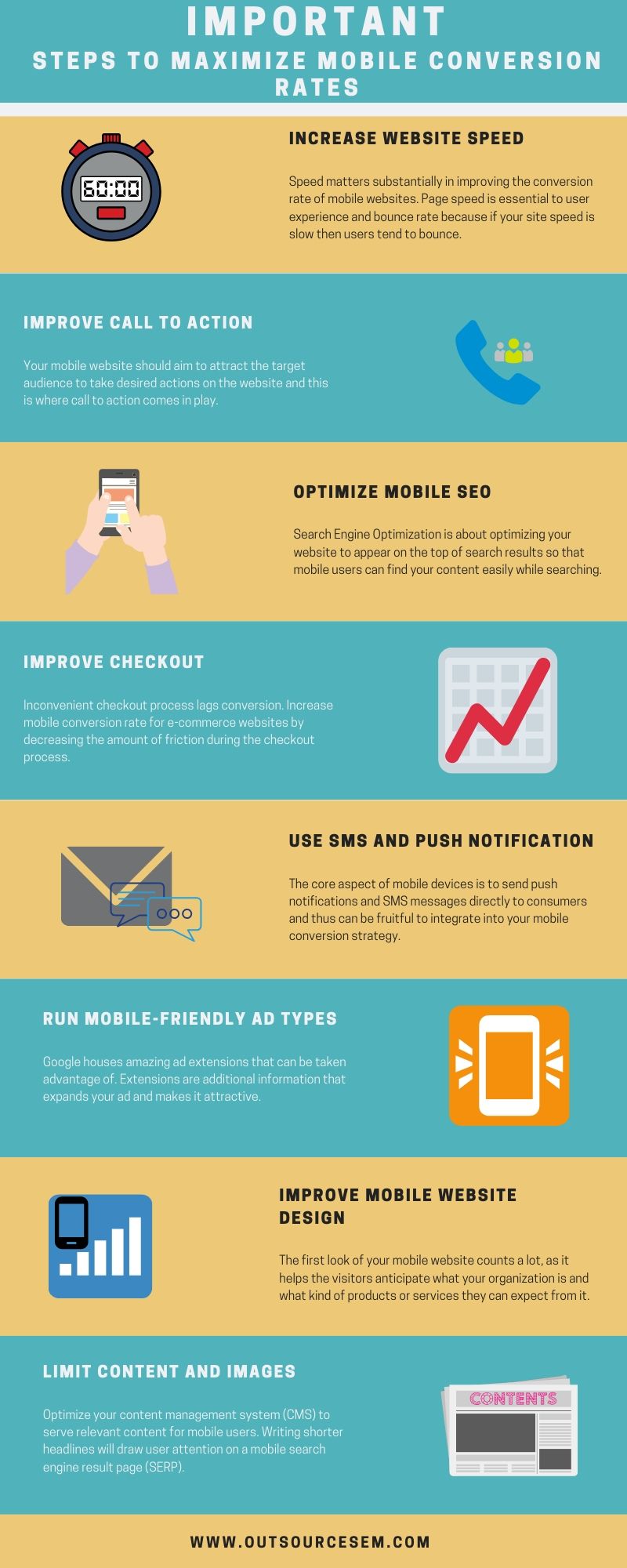The development of smartphone technology has introduced innovative reforms in the world of business. Hence, it becomes pertinent to create a mobile-friendly website to offer unhindered user experience so that you don’t lose potential customers. When you plan your ad campaign with an intention to get conversions on desktop - you optimize your campaigns, ad groups and landing page according to it. But the site browsing experience on a mobile device is different than a desktop. The behavior of mobile users is vastly different than that of the desktop user and therefore you should tailor your marketing strategies with the idea that people would also be using their mobiles along with the desktops thereby focusing on mobile conversion rates.
What is mobile conversion rate?
Before understanding the approaches for improving conversion rates for mobile website, it is essential to know some basic information about the mobile conversion rate. Mobile conversion rate can be defined as the percentage of people who took the desired result on the mobile marketing campaign among the total number of people that witnessed the campaign. Hence, it is easy to understand that the higher the percentage of mobile conversion rate, the more the success of a marketing campaign.
But conversions on mobile website is different than the desktop site. Since web browsing isn’t the only purpose of mobile devices, it’s difficult to say what might catch a user’s interest. The following information is aimed to guide you through the important steps that can be taken to maximize mobile conversion rates and to build up the mobile audience of a business.

Increase website speed: Speed matters substantially in improving the conversion rate of mobile websites. Slow-loading websites can lead to less traffic. A 1 second delay in page speed response can result in a 7% reduction in conversion. Page speed is essential to user experience and bounce rate because if your site speed is slow then users tend to bounce. The major share of mobile page load speed is termed as Render Start Time (RST) which represents the time taken for the first content to appear on the mobile screen. Moreover, mobile sites with better RST can expect 50% more engagement thereby implying the possibilities for higher mobile conversions.
Here are some ideas to ensure your mobile website speed:
• Implement a mobile-responsive website design. This could include creating a separate mobile domain, responsive web design (RWD), a progressive web app (PWA) or Google AMP code.
• Follow Google's best practices for improving site speed on mobile devices.
• Eliminate pop-up ads.
• Reduce the number of different JS and CSS files.
• Implement accelerated mobile pages (AMP) code.
Regularly check your website to make required updates, in case any new content or changes slow down your site. Take Google’s PageSpeed Insight and check all the issues related to speed on your site.
Improve call to action: Your mobile website should aim to attract the target audience to take desired actions on the website and this is where call to action comes in play. CTAs suggest a path to the visitor after offering compelling reasons to get involved with the site. Hence, it’s important that you include a call to action button on every web page. A good call to action increases conversion and the lack of it can affect your mobile conversion rate negatively. It is also important that you provide a visual and tactile response to each click or completed action. Your CTA should be clear and represent the action your visitors are taking. You can also generate a "thank you" page after the completion of the action.
Optimize mobile SEO: Search engine optimization is about optimizing your website to appear on the top of search results. With the launch of Google’s mobile-first index, which will use the mobile version of sites for ranking and indexing, it has become necessary to optimize the website so that mobile users can find your content while searching. A good start would be to check the mobile-friendliness of your website by using Google’s mobile-friendly test. This will help you in obtaining recommendations for improvement of your mobile site that can lead to productive results for the search presence.
You can also optimize content for mobile devices through other techniques. This includes:
• Optimizing page titles and descriptions by using short and simple headlines.
• Using high-performing phrases and keywords that generate more traffic.
• Linking internally and to genuine external sites.
Improve checkout: One of the main reasons why people avoid making purchases over mobile is because of inconvenient checkout processes. One way to increase mobile conversion rate for e-commerce websites is by decreasing the amount of friction during this process. Apart from that, typing details with tiny keys and navigation is also an issue.
Keep in mind the following points to avoid cart abandonment:
• Lessen the number of steps it takes to reach checkout by using a progress indicator to show the remaining process left.
• Allow the users to guest checkout, so they don't necessarily have to make an account.
• Offer simple and integrated payment service which are secure and trusted.
• Ask only required details during checkout like payment information, address and so on.
Use sms and push notification: The core aspect of mobile devices is to send push notifications and SMS messages directly to consumers and thus can be fruitful to integrate into your mobile conversion strategy. Using push notification to advertise limited-period offers can drive traffic to your website. To truly raise your potential to convert leads, imply urgency and fear of missing out (FOMO) marketing within your notifications. You can use SMS service to get people’s emails and encourage them to opt into your email list.
Run mobile-friendly Ad types: Google houses amazing ad extensions that can be taken advantage of. Extensions are additional information that expands your ad, thus making it stand out and directing users to relevant content on your website. There are different ad extensions depending on your website's need. The most commonly used extensions type for PPC ads is site link extensions. They allow you to extend your ad copy more than standard character limits and show anywhere from two to six sitelinks rather than just having a single landing page. Although, they are mostly suitable for the desktop user who can open multiple tabs on their browser.
Regarding mobile websites, you need extensions designed for a smaller screen precisely and efficiently with how people search and communicate with their phone, like call extensions and the newer message extensions. These extensions are beneficial in terms of lead generation and remarketing of products.
• Call extensions let you add phone numbers to your ad and help the visitors to reach you directly from the ad.
• Message extension facilitates visitors to text message your business for more information with just one tap.
Improve mobile website design: A Google study has revealed that it takes less than a second for visitors to form an impression about your website. The first look at the mobile website for your business counts a lot, as it helps the visitors anticipate what your organization is and what kind of products or services they can expect from it. A poorly-designed and unresponsive mobile website may result in low conversion rates. Hence, you should be mindful of usability and take utmost care that your mobile site visitors find the information they need.
You can also use the following tips to make your website mobile user-friendly:
• Create a mobile responsive website design.
• Tailor your onsite marketing campaigns to be mobile-friendly.
• Checking the user flow to ensure mobile users get access to the suitable information that boosts them take action to convert.
• Make navigation easy and simple by mobile standards.
Limit content and images: Optimize your content management system (CMS) to serve relevant content for mobile users. Mobile users usually lack the patience to read the entire website on their tiny screens; so keep your content brief and crisp. Writing shorter headlines will draw user attention through their social news feed or on a mobile search engine result pages (SERPs).
Images contribute substantially to the improvement of mobile conversion rates. Not only are they responsible for drawing the attention of visitors but also develop a bond with them. Although, that doesn't spare them of the allegation in the awful amount of time they take to load. Optimize your images using smaller pixels and the .jpeg format, thus making them load faster while also utilizing the minimal amount of space you have on a smaller screen.
While there is no sure-shot way of improving mobile conversion rates, creating a good user experience can lead to more conversions. The more you optimize your website to cater to this segment of user, the more conversions you’ll get. Customers are no longer glued behind a desk and staring at desktop screens rather they’re browsing the internet the new way. It's the golden age of opportunities with expansion in the usage of mobile devices, so bag them to get a higher conversion rate for your business.
